
An impact crater is a circular depression in the surface of a solid astronomical object formed by the hypervelocity impact of a smaller object. In contrast to volcanic craters, which result from explosion or internal collapse, impact craters typically have raised rims and floors that are lower in elevation than the surrounding terrain. Lunar impact craters range from microscopic craters on lunar rocks returned by the Apollo program and small, simple, bowl-shaped depressions in the lunar regolith to large, complex, multi-ringed impact basins. Meteor Crater is a well-known example of a small impact crater on Earth.

The Chicxulub crater is an impact crater buried underneath the Yucatán Peninsula in Mexico. Its center is offshore near the community of Chicxulub, after which it is named. It was formed slightly over 66 million years ago when a large asteroid, about ten kilometers in diameter, struck Earth. The crater is estimated to be 180 kilometers in diameter and 20 kilometers in depth. It is the second largest confirmed impact structure on Earth, and the only one whose peak ring is intact and directly accessible for scientific research.
Kursk is a city in Russia.

The Beaverhead impact structure is the 2nd largest impact structure within the U.S. It lies within the states of Idaho and Montana. Estimated at 60 kilometers (37 mi) in diameter, it is the 9th largest impact crater on Earth.

Kara is a meteorite crater in the Yugorsky Peninsula, Nenetsia, Russia.

Mistastin crater is a meteorite crater in Labrador, Canada which contains the roughly circular Mistastin Lake. The lake is approximately 16 km (9.9 mi) in diameter, while the estimated diameter of the original crater is 28 km (17 mi). The age of the crater is calculated to be 36.6 ± 2 million years (Eocene).
Obolon' crater Ukrainian: Оболонь is a 20 km (12 mi) diameter buried meteorite impact crater situated about 200 km (120 mi) southeast of Kyiv in Ukraine . The site has been drilled, which revealed the presence of shocked minerals and impact melt rock; the high chlorine content of the latter suggesting that the area was covered by shallow sea at the time of impact. One estimate puts the age at 169 ± 7 million years.
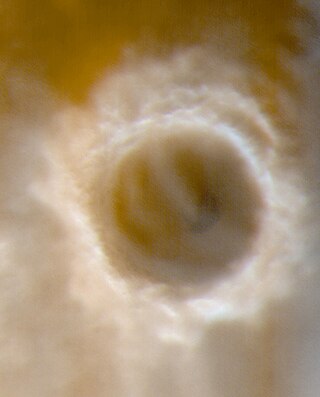
Lomonosov is a crater on Mars, with a diameter close to 150 km. It is located in the Martian northern plains. Since it is large and found close to the boundary between the Mare Acidalium quadrangle and the Mare Boreum quadrangle, it is found on both maps. The topography is smooth and young in this area, hence Lomonosov is easy to spot on large maps of Mars.

Eddie is a crater in the Elysium quadrangle of Mars. It is 89 km in diameter and was named after Lindsay Eddie, a South African astronomer (1845–1913).

Puńsk is an impact crater on Mars, located in the Oxia Palus quadrangle at 20.8° N and 41.2° W. It measures 11.6 kilometers in diameter and was named after the village of Puńsk in Poland.

Dilly is a crater in the Elysium quadrangle of Mars, located at 13.24° North and 202.9° West. It is only 1.3 km in diameter and was named after Dilly, a town in Mali.
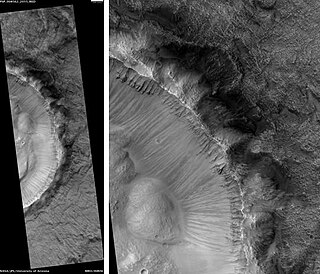
Grindavik is an impact crater in the Oxia Palus quadrangle of Mars, located at 25.39° North and 39.07° West. It is 12 km (7.5 mi) in diameter and was named after Grindavík, a town in Iceland. Impact craters generally have a rim with ejecta around them, in contrast volcanic craters usually do not have a rim or ejecta deposits. As craters get larger they usually have a central peak. The peak is caused by a rebound of the crater floor following the impact.
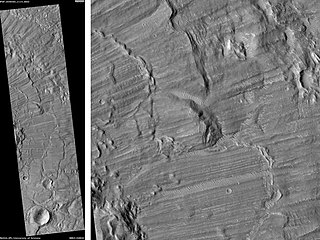
Bacolor is a crater in the Casius quadrangle of Mars, located at 33 North and 241.4 West. 20.8 kilometers (12.9 mi) in diameter, it is named after the municipality of Bacolor in Pampanga, Philippines.
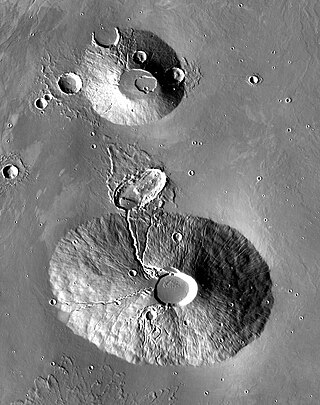
Rahe is a crater on the planet Mars in the Tharsis quadrangle, positioned at 25.05° north latitude and 262.52° east longitude, between the volcanoes Ceraunius Tholus and Uranius Tholus. It measures approximately 34 kilometers in diameter and was named after Jürgen Rahe, a German-American astronomer and NASA science program director.
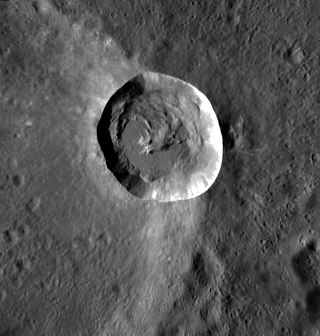
Mena is a crater in the Beethoven quadrangle on Mercury. Its name was adopted by the International Astronomical Union in 1976. Mena is named for the Spanish poet Juan de Mena, who lived from 1411 to 1456.

Sinton is a crater in the Ismenius Lacus quadrangle on Mars. Sinton crater lies in the northern hemisphere, south of the very large crater Lyot and west of Ismeniae Fossae. It was named after Harvard astronomer William M. Sinton. The name was approved in 2007.

Gledhill is an impact crater in the Hellas quadrangle of Mars, located at 53.2°S latitude and 87.1°E longitude. It is 78.5 km in diameter. It was named after British astronomer Joseph Gledhill, and the name was approved in 1973 by the International Astronomical Union (IAU) Working Group for Planetary System Nomenclature (WGPSN).

Baltisk is a crater in the Argyre quadrangle of Mars. It was named after a town in Russia in 1976. Baltisk is located on the western edge of the Argyre impact basin.



















